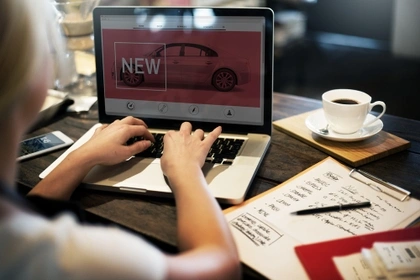What is depreciation?
Depreciation is another way to describe the process of cars losing value over time. All cars, except for classic and rare collectibles, lose value as they age.
The rate of depreciation is typically fastest in the weeks and months immediately after a new car has been purchased.
Car depreciation isn’t an exact science, and a range of different factors can affect a used car’s value, but owners of brand-new vehicles can expect to see a drop in value of up to 35% in the first year and nearly double that after three years. Happily, the rate of depreciation will usually slow in subsequent years, which means that you may find yourself in negative equity at the beginning of your loan term but should move into positive equity towards the end of your agreement.
How can I slow down the rate of depreciation?
The rate of depreciation is unpredictable and can be influenced by external factors such as trends in the used car market. Even so, there are steps you can take to help your car maintain as much value as possible over time:
- Keep the car well-maintained
Taking good care of your car can help to slow the rate of depreciation. Consider getting minor repairs fixed quickly. Avoid tight parking spaces. And smooth out any small bumps or scratches as they occur to keep the bodywork looking healthy.
- Avoid unpopular modifications
Modifications can be controversial, as some can add value to your car while others can make it less desirable. Depending on the terms of your finance agreement, modifications may be prohibited but many car dealers recommend that owners avoid adding divisive features like extra-low spoilers, flared wheel arches, and expensive sound systems.
- Maintain a complete service history
Used car buyers often find a complete service history reassuring as it proves the vehicle has been looked after. Looking at the manufacturer’s guidelines can let you know how often you should book your car in for an interim or full service at the local garage.
- Keep your mileage low
While driving long distances might be unavoidable if you travel for work or need to regularly visit family across the country, keeping your annual mileage low could help you slow down the rate of depreciation and make your car more desirable on the used car market.
- Stick to popular car colours
You might have always wanted a canary yellow car or leopard-print interior, but potential buyers might not be so keen. In the UK, the most popular car colours tend to be more conservative, with black, grey, and white regularly topping the charts. While trends can come and go, neutral colours have so far stood the test of time.
- Choose the right time to sell
When you’re ready to let go of your car, consider when might be the right time to sell. Of course, you might not have the luxury to wait, but selling at peak time could increase your chances of securing a great price. A sporty convertible, for example, might not be so appealing on a snowy day in December, while a family-sized SUV might fly off your driveway if you list it ahead of the school holidays.
When is negative equity a problem?
If you have bought your car on hire purchase (HP) car finance or with a personal loan and plan to keep it for several years, you might not be too concerned that it’s worth less than your outstanding finance. However, negative equity can become an issue if your circumstances change and you need to change car during your loan term.
With both HP and personal contract purchase (PCP) car finance, you won’t become the car’s legal owner until you reach the end of your loan term and finish making all your repayments (including the balloon payment in a PCP loan). If you wish to end your agreement early and sell the car, you’ll need to settle the finance first.
Unfortunately, if your car is worth less than the settlement figure quoted by your finance company, you can end up out of pocket. This also applies if you want to part-exchange your car, and you might need to pay the difference to the dealership if you want them to agree to the trade.
Negative equity can also be a problem if your car is stolen or written off. Most car insurance policies will only pay you the current market value of the car, rather than the original purchase price that your car finance is based on. If your insurance payment doesn’t fully cover your outstanding finance, you’ll still be liable to make up the difference, even if you no longer have access to the vehicle. To help prevent ending up in this situation, some people choose to take out a GAP insurance policy.
Hire purchase and negative equity
HP finance allows you to spread the cost of a new or used car into fixed monthly repayments, paid over a period of between two and five years. You may need to put a deposit down upfront, but once you’ve finished making all the repayments and paid the ‘Option to Purchase’ fee, you’ll become the car’s legal owner.
As HP car finance is a route to vehicle ownership and features relatively high monthly repayments, the chance of ending up in negative equity is lower than with some other types of finance. Though you may find that you’re in negative equity near the beginning of your agreement, this often reduces over time as the outstanding finance amount decreases and the car’s rate of depreciation slows.
Personal contract purchase and negative equity
PCP car finance works a little differently from HP finance, as you don’t borrow the full purchase price of the vehicle. Instead, you borrow an amount that represents the value the lender predicts your car will lose during your loan term. The remaining value, known as the Guaranteed Minimum Future Value (GMFV) or balloon payment, must be paid at the end of your agreement if you wish to take legal ownership of the car. However, you don’t have to buy the car – you can simply hand it back to the lender instead if you wish.
Negative equity can become an issue in a PCP agreement if you plan to use any equity in the car as a deposit in a new car finance deal. If the financed car is worth less than the balloon payment, you’ll be in negative equity, meaning you won’t have any to use as a deposit towards a new car. Negative equity can also be a more frequent occurrence with PCP loans, as your monthly repayments are usually lower than other finance options and don’t cover as much of the car’s original value.
What options do I have with negative equity?
Don’t panic if you find yourself in negative equity, as there are options available:
Do nothing
If you can still afford your monthly repayments and are happy to keep your car, there’s no need to do anything. You can simply keep your current deal and continue making payments until you reach the end of your loan term. If you’re in a PCP agreement and find yourself in negative equity, you can choose to hand the car back at the end of your loan and start fresh.
Choose voluntary termination
If you’re struggling to keep up with your car finance repayments or no longer need your vehicle, you might not want to wait until the end of your loan term. Under Section 99 of the Consumer Credit Act 1974, you have the right to voluntarily terminate your loan and hand the car back if you’ve already paid 50% of the total amount payable. This amount includes your initial loan, any interest or charges, and your balloon payment if you’re in a PCP deal. If you’ve not yet reached the 50% threshold, you have the option of making a one-off payment to make up the difference, so it could be something to consider if you can afford it.
Pay off the negative equity
Depending on the terms of your car finance agreement and your individual circumstances, you might be able to sell or trade in your vehicle and make up the difference.
Apply for negative equity car finance
Negative equity car finance allows you to take out a new loan to cover the cost of clearing your existing finance agreement and buying a new vehicle. These costs will be combined into affordable monthly repayments plus interest – you’ll only have to make one payment to one lender each month.
As with any type of car finance, your eligibility will depend on your circumstances, affordability, and credit history, but negative equity car loans could be an option if you need access to a vehicle and can’t afford to clear your existing finance. You might even find that you’re able to save money over time if you choose to switch to a cheaper vehicle.
Can I trade in a car with negative equity?
With an HP or PCP car finance deal, the lender will be the car’s legal owner until you reach the end of your agreement (and pay the balloon payment in a PCP). If you want to part-exchange your car before reaching the end of your agreement, you’ll need to settle the finance first. Your lender can provide you with a settlement figure, which will be the amount you need to pay to end your loan and take ownership of the car.
In a standard part-exchange deal, the dealership will often pay the settlement figure on your behalf and take any profit off the price of your new car. However, if you need to trade in a car with negative equity, you may need to pay the difference between the settlement figure and the car’s new value so that the dealer will accept the vehicle.
How to avoid negative equity?
While there’s no way to guarantee that you won’t end up in negative equity, there are steps you can take to help maintain your car’s value over time.
- Do your research
Different cars lose value at different rates, so it may be worth looking into the makes and models that are enduringly popular. The age of the car can also make a difference, so you might want to consider buying a used car rather than a brand-new vehicle.
- Increase your deposit
No-deposit car loans are available, but the more money you’re able to put down upfront, the less you’ll need to borrow. This will lower your overall loan amount, the total interest payable, and can help you avoid ending up in negative equity.
- Check the terms and conditions
If you agree to a loan with a long term and a high loan amount, you may increase your chances of ending up in negative equity, as your car could lose value at a faster rate than you’re paying off the finance.
- Take care of your car
Cars that have been well looked after can retain more value over time than those in poor condition. If you can keep your mileage low, make repairs quickly, preserve your paperwork, and book the car in for regular services, you may be able to avoid or limit negative equity.
- Consider a hire purchase agreement
Hire purchase agreements may be considered among the best for reducing the risk of ending up in negative equity. But what’s right for you will depend on your individual needs and circumstances, including your financial history.
Get Car Finance up to £100,000
- No deposit needed
- Check your eligibility without impacting your credit score
- Rates from 8.9%* APR
'Representative Example: Borrow £12,000 over 5 years with a £0 deposit. Representative 20.5% APR fixed rate. Monthly payment: £309.93. Option to purchase fee £10 payable. Total cost of credit: £6,605.80. Total amount repayable: £18,605.80.
We are a credit broker, not a lender. We partner with CarFinance 247 Limited, a credit broker (not a lender) who works with a wide panel of lenders.
Disclaimer: We make every effort to ensure content is correct when published. Information on this website doesn't constitute financial advice, and we aren't responsible for the content of any external sites.






